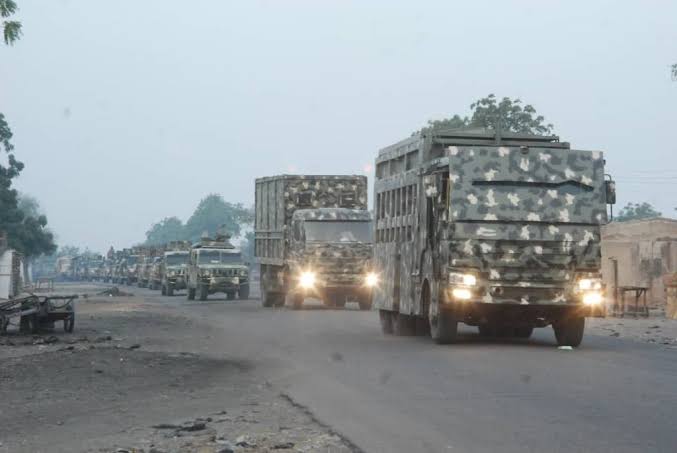Overtaking Military Convoy: Consequences Under Nigerian Law
Introduction
Overtaking a military convoy is a serious offense in Nigeria, punishable under various laws. This article examines the consequences of overtaking a military convoy under Nigerian law.
Relevant Laws
- The Armed Forces Act (AFA) 2004: Section 119 prohibits obstructing or interfering with military operations, including convoys.
- The Road Traffic Act 2004: Section 35 prohibits reckless driving, including overtaking military convoys.
- The National Security Agencies Act 2004: Section 15 empowers security agencies to take necessary actions to maintain national security.
Consequences of Overtaking Military Convoy
- Arrest and Detention: Security personnel may arrest and detain anyone who overtakes a military convoy.
- Prosecution: Offenders may be prosecuted under the AFA, Road Traffic Act, or National Security Agencies Act.
- Imprisonment: Conviction may result in imprisonment for up to 5 years (AFA) or 2 years (Road Traffic Act).
- Fine: Offenders may be fined up to ₦50,000 (AFA) or ₦20,000 (Road Traffic Act).
- Vehicle Confiscation: The vehicle used to overtake the convoy may be confiscated.
- Tort Liability: Offenders may be liable for damages or injuries caused to military personnel or equipment.
Court Rulings
In Aoku v. State (2017), the Court of Appeal upheld a 5-year imprisonment sentence for overtaking a military convoy.
Precautions
To avoid consequences:
- Exercise caution when approaching military convoys.
- Maintain a safe distance.
- Follow traffic rules and regulations.
- Avoid reckless driving.
Conclusion
Overtaking a military convoy is a serious offense in Nigeria, carrying severe consequences under various laws. It is essential to exercise caution and respect military operations to avoid prosecution and punishment.
References
- Armed Forces Act 2004 (Cap A20, Laws of the Federation of Nigeria).
- Road Traffic Act 2004 (Cap R9, Laws of the Federation of Nigeria).
- National Security Agencies Act 2004 (Cap N14, Laws of the Federation of Nigeria).
- Aoku v. State (2017) NWLR (Pt. 1578) 214.
Convoy Etiquette: Why Convoys Should Not Be Overtaken
A convoy is a group of vehicles traveling together, typically for security, ceremonial, or logistical purposes. Whether it’s a military operation, a VIP escort, or a coordinated transport, proper convoy etiquette is critical to ensure safety, maintain discipline, and fulfill the convoy’s mission. One of the most important rules when encountering a convoy on the road is never to overtake it unless explicitly permitted. This article explores convoy etiquette and the specific reasons why overtaking convoys is discouraged.
Understanding Convoy Operations
A convoy operates with strict coordination, often adhering to predefined protocols and formations. These vehicles may travel in close succession to ensure security and efficiency. Convoys are usually led by a designated lead vehicle and monitored by a rear vehicle (also known as the “tail end”), ensuring smooth movement and communication among the participants.
Convoys serve various purposes, such as:
•Military Operations: Moving troops, equipment, or sensitive cargo.
•VIP or State Escorts: Protecting high-ranking officials or dignitaries.
•Humanitarian or Logistics Missions: Delivering aid or goods in organized groups.
Given the importance of maintaining order, any disruption, including overtaking, can pose significant risks.
Why Convoys Should Not Be Overtaken
- Security Concerns
In military or VIP convoys, security is paramount. Vehicles in a convoy are often on high alert for potential threats. An attempt to overtake may be perceived as hostile, prompting defensive measures. Security personnel in the convoy may act to neutralize what they interpret as a risk, leading to unintended consequences for both the overtaking driver and the convoy. - Risk of Accidents
Convoys typically maintain a controlled speed and spacing. Overtaking vehicles disrupt this formation, increasing the risk of collisions. Convoys may include large vehicles, slow-moving trucks, or vehicles with limited visibility, making it hazardous for an overtaking vehicle to navigate safely.
Additionally, convoys often communicate via radio to manage movements. An uncoordinated vehicle within the formation can cause confusion, leading to accidents.
- Legal Implications
In many countries, overtaking a convoy, especially one involving the military or government officials, is considered a traffic violation. It may lead to fines, vehicle impoundment, or more severe legal consequences. Drivers should always respect laws and regulations concerning convoys to avoid these penalties. - Delays to the Convoy’s Mission
Convoys operate on strict schedules. Disruptions caused by overtaking vehicles may delay their mission, whether it’s a time-sensitive military operation, a humanitarian delivery, or a VIP movement. Maintaining the convoy’s integrity is essential for efficiency and mission success. - Respect for Protocol and Authority
Convoys often represent authority, such as the military, government, or humanitarian agencies. Respecting convoy etiquette demonstrates acknowledgment of their purpose and role. Overtaking a convoy can be viewed as disrespectful, undermining the discipline and order they symbolize.
Number of a Convoy
The minimum number of vehicles a convoy can have is typically two, depending on the context and purpose. Here’s why:
1.Military or Security Convoys:
A convoy often requires at least:
•A lead vehicle to set the pace and direction.
•A rear vehicle to monitor the formation and provide security or communication.
With just two vehicles, they can still function as a small convoy, particularly for high-priority or low-profile missions.
2.Ceremonial or VIP Convoys:
A lead escort and a primary vehicle transporting the dignitary can constitute the minimum size, as additional vehicles are optional based on the level of security or formality required.
3.Logistical Convoys:
For transporting goods or equipment, at least two vehicles ensure mutual support and backup in case of breakdowns or emergencies.
While two is the minimum, the size of a convoy is typically dictated by the operational, security, or logistical needs.
How to Behave Around Convoys
•Maintain a Safe Distance: Always keep a reasonable distance behind the last vehicle in the convoy to avoid appearing intrusive or threatening.
•Wait for Signals: Only overtake if explicitly signaled or permitted by the convoy’s personnel.
•Be Patient: Convoys usually travel at a steady pace. Exercise patience and allow them to complete their movement safely.
•Stay Alert: Pay attention to convoy movements and any instructions from traffic officers or convoy escorts.
Conclusion
Convoys are more than just groups of vehicles; they represent discipline, order, and purpose. Overtaking a convoy not only endangers lives but also disrupts the mission at hand, whether it’s security, logistics, or a ceremonial task. By respecting convoy etiquette, road users contribute to safer roads and smoother operations for everyone involved. When you encounter a convoy, remember: patience and caution are paramount. Never overtake unless explicitly allowed—it’s a matter of safety, respect, and compliance.

